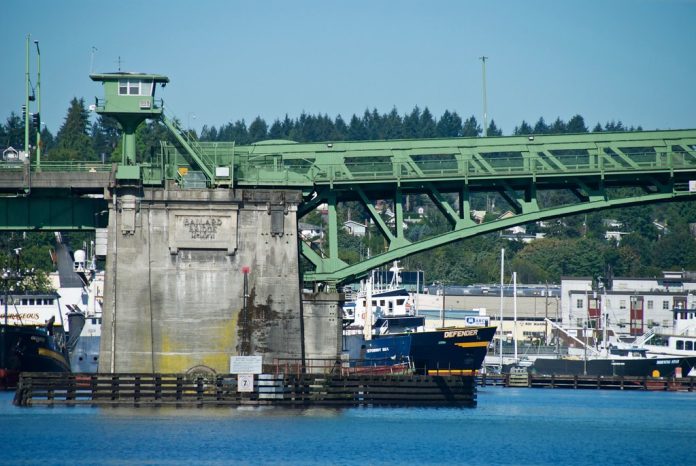Addressing current substandard pedestrian and bike infrastructure stands out as a top SDOT and community priority for rehabilitation or replacement of the Ballard Bridge.
The Seattle Department of Transportation (SDOT) recently published the results of an online survey it conducted on the Ballard Street Bridge. The online survey is part of a Ballard Bridge Planning Study, which has been funded by the Move Seattle levy and is being completed by SDOT throughout 2019.
According to SDOT the Ballard Bridge Planning Study will:
• Explore feasible rehabilitation and replacement options;
• Survey community members on their transportation needs and values;
• Evaluate multimodal mobility and access options;
• Investigate cost-effective and constructible structure types;
• Identify associated costs, risks, benefits, and trade-offs of each feasible alternative; • Provide a comparison of alternatives to inform future Interbay Corridor investments.
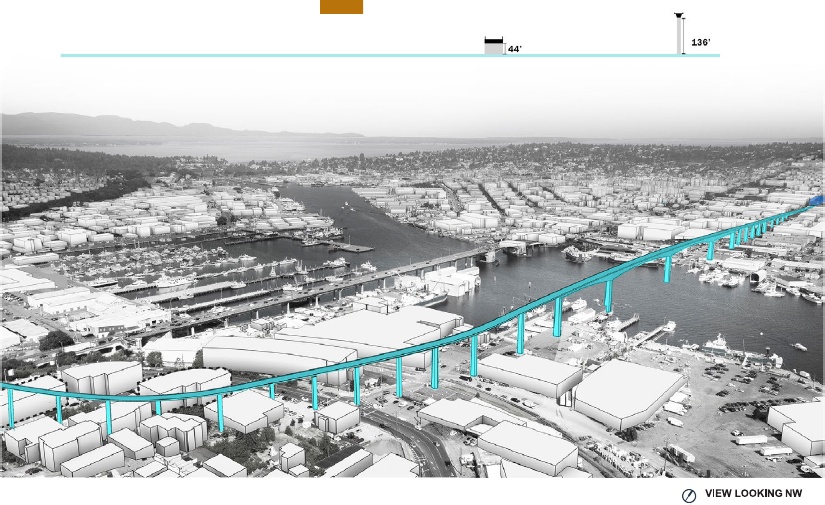
The City may also be holding out some hope that the Ballard Bridge could be replaced in conjunction with the new light rail bridge planned with Sound Transit 3 (ST3), lowering construction costs to the city. The problem is the Seattle’s elected leaders have indicated a preference for light rail tunnels for Ballard and West Seattle, and Sound Transit hasn’t been too interested in either adding more tunneling or joining a grand Ballard Bridge replacement scheme. More realistically, the opening of Ballard light rail could provide enough transportation capacity to carry the load during Ballard Bridge reconstruction or rehabilitation work.

Preliminary information from SDOT’s online survey shows that almost as many users responded that they cross the bridge by transit, biking, or walking (total of 77%) as by automobile (83%), and usage of bikes for transportation (29%) was approached reported transit usage (31%).
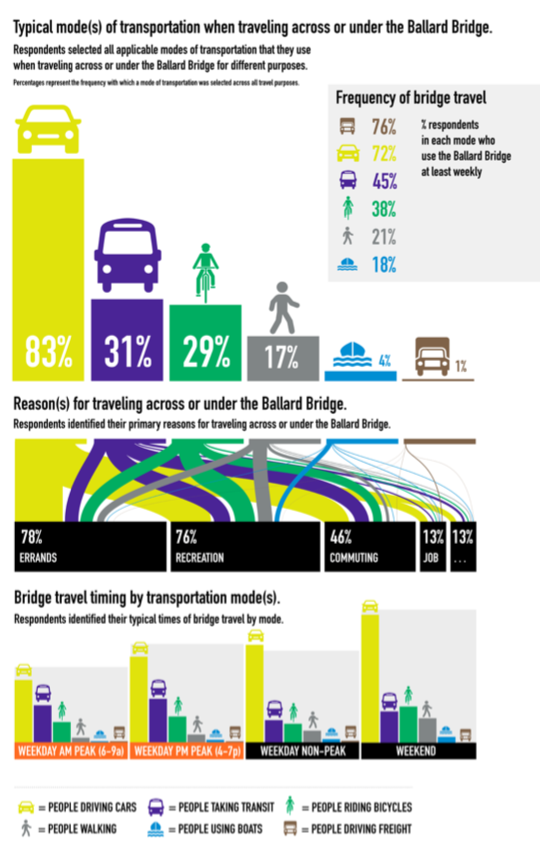
With these relatively high usage rates, it’s not a surprise that a majority of respondents cited improving safety infrastructure for biking and walking as at the top of their list of priorities for the bridge, especially since the Ballard Bridge is known for narrow sidewalks that squeeze pedestrians and cyclists into a roughly three and a half foot space.
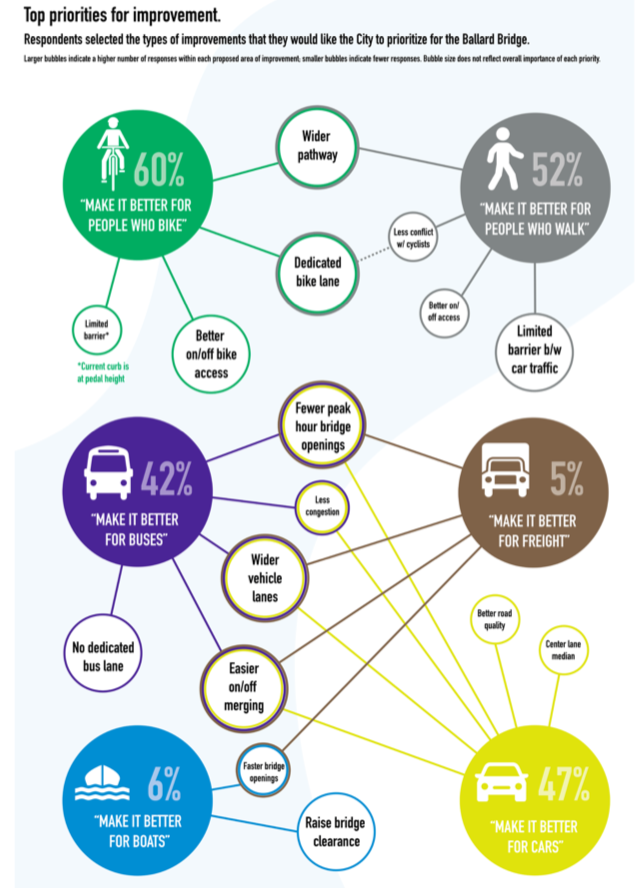
Longstanding Safety Concerns
While the Ballard Bridge is currently assessed as in good structural condition, in part because of a seismic retrofit it received in 2014, the frequent opening of the bascule leaves, or drawbridge, to accommodate tall ships results in traffic delays for transit, freight, and car traffic seeking to cross from Ballard to Interbay. Additionally, narrow sidewalks that can be easily blocked by debris are known to create dangerous conditions for cyclists and pedestrians.
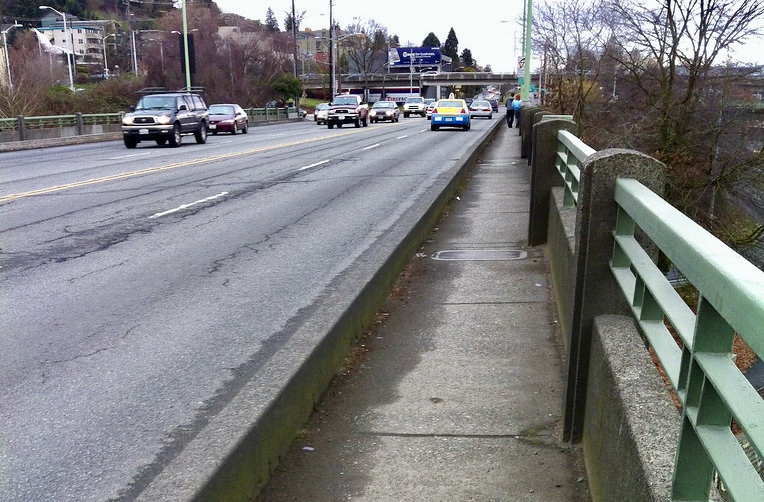
In 2008, cyclist Terry McMacken died after sustaining injuries in a crash on the Ballard Bridge. McMacken’s tragic death drew attention to the problem of the three-and-a-half foot sidewalks and ten inch curb that separate pedestrians and cyclists from vehicle traffic for the majority of the bridge’s length.
However, despite pressure from safety advocates like Connect Ballard and the Seattle Bicycle Safety Board, which created a list of recommendations for safety upgrades to the Ballard Bridge back in 2015, SDOT has been slow to move forward with changes.
The agency’s response can be attributed at least in part to the high cost of rehabilitating the bridge. A 2017 Ballard Bridge Sidewalk Widening Concept Study completed for SDOT by consultant firm BergerABAM showed steep costs for all three alternatives examined. For example, Alternative 1, which would only widen the sidewalk to about four and a half feet on both sides, was estimated to cost anywhere from $21 to $36 million dollars.
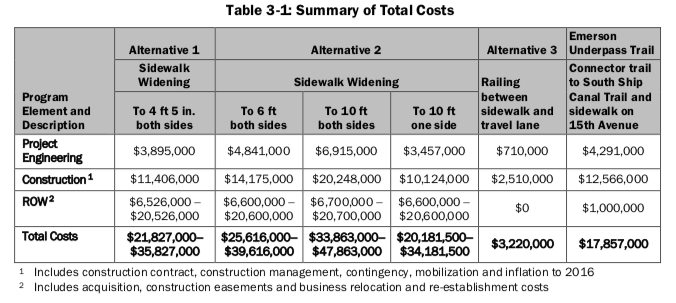
The high projected costs for relatively small improvements to the Ballard Bridge revealed by BergerABAM’s study led to the Seattle Bike Blog creating its own additional alternatives for the Ballard Bridge, which included Alternative 4, a new pedestrian and bike only bridge, similar to the Northgate Pedestrian and Bicycle Bridge that will cross I-5, and Alternative 5, a Ballard Bridge lane redesign inspired by bridge projects undertaken in Vancouver, BC, that eliminated a lane of vehicle traffic to add a protected bike lane. The redesign would potentially come with a reversible center lane that would change to accommodate traffic patterns.

While Alternative 4 would likely be prohibitively expensive, the Seattle Bike Blog has promoted Alternative 5 as providing the potential to “save tens of millions of dollars and improve safety and access for people walking across the Ballard Bridge in a much shorter timeframe.” For comparison it cites Vancouver’s Burrard Street Bridge project, which only cost $1.4 million and is now celebrated as the busiest bike lane in North America with more than one million cyclists crossing the bridge each year.
A New Ballard Bridge?
According to SDOT, while the Ballard Bridge Planning Study will not culminate in a preferred alternative, by the end of the year the planning study will present a comparison of feasible alternatives for stakeholders to consider as SDOT and other Seattle government officials review funding options for either a rehabilitated or future Ballard Bridge.
The inclusion of two proposed future bridge concepts in the online survey suggests that SDOT is looking seriously at eventual replacement of the Ballard Bridge, although with more pressing needs to address–such as addressing the seismically vulnerable Magnolia Bridge–plans for a new Ballard Bridge would likely not materialize for years to come.
The three technical options currently included in the planning study include a fixed high bridge, mid-level moveable bridge, and rehabilitation of the existing low-level moveable bridge.

Replacement of the existing bridge with either a high-level or mid-level bridge would address the problem of bridge openings, which can cause serious delays to all modes of traffic on the bridge. However, such taller structures would also increase crossing times for pedestrians and cyclists.
Moving forward, SDOT will also need to coordinate Ballard Bridge planning efforts with Sound Transit’s Ballard Light Rail Link Extension and future redevelopment of the Interbay Armory site.
In recognition of significant residential and commercial growth Ballard has experienced in recent decades, and the potential for future light rail and new Interbay development to expand on that growth, SDOT has applied for and received state funding for a Ballard-Interbay Regional Transportation System Corridor Study.
Readers who want to keep up-to-date with the Ballard Bridge Planning Study can sign up for the project listserv. Questions and comments can also be emails to the project team at BallardBridge@seattle.gov.
Natalie Bicknell Argerious (she/her) is a reporter and podcast host at The Urbanist. She previously served as managing editor. A passionate urban explorer since childhood, she loves learning how to make cities more inclusive, vibrant, and environmentally resilient. You can often find her wandering around Seattle's Central District and Capitol Hill with her dogs and cat. Email her at natalie [at] theurbanist [dot] org.

